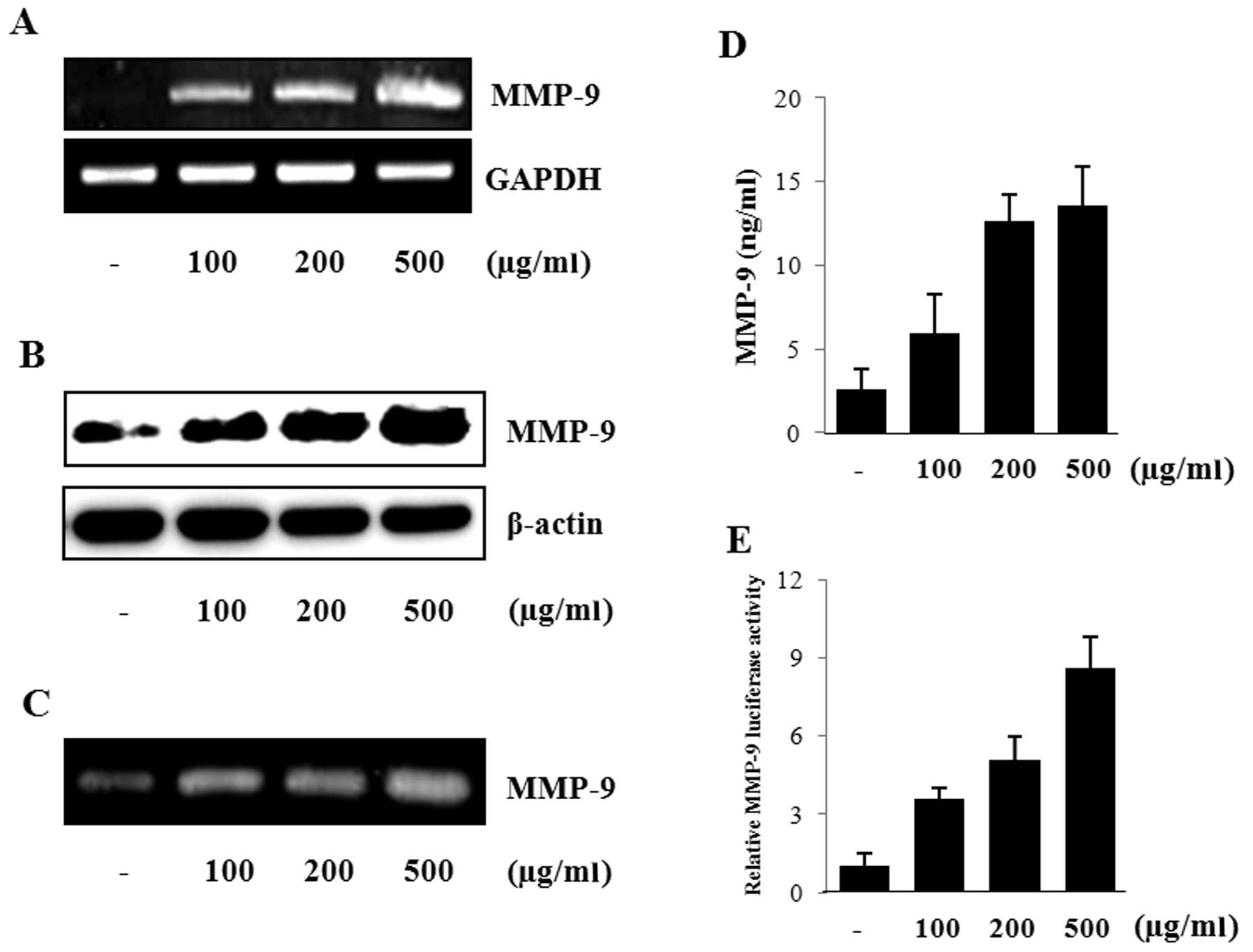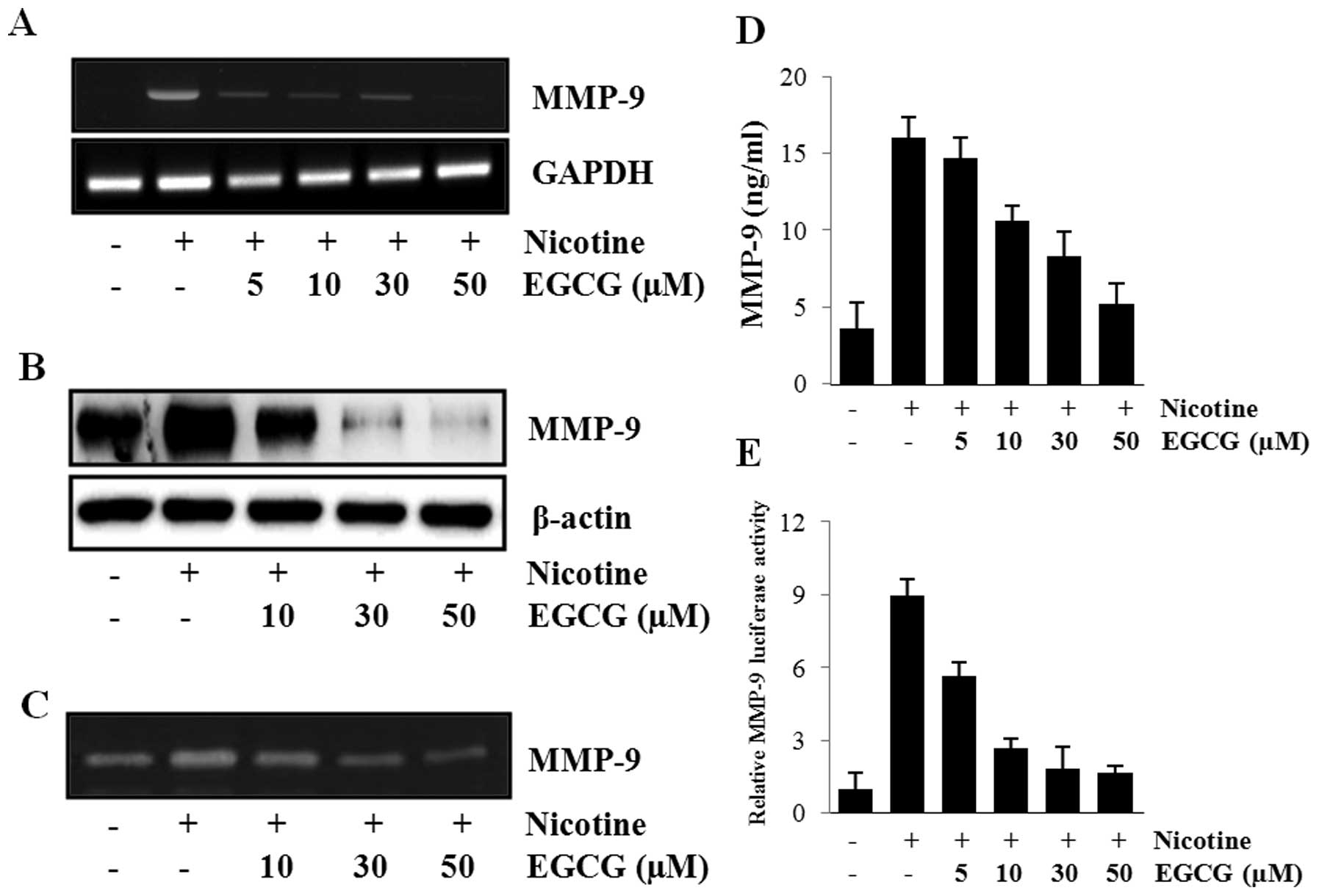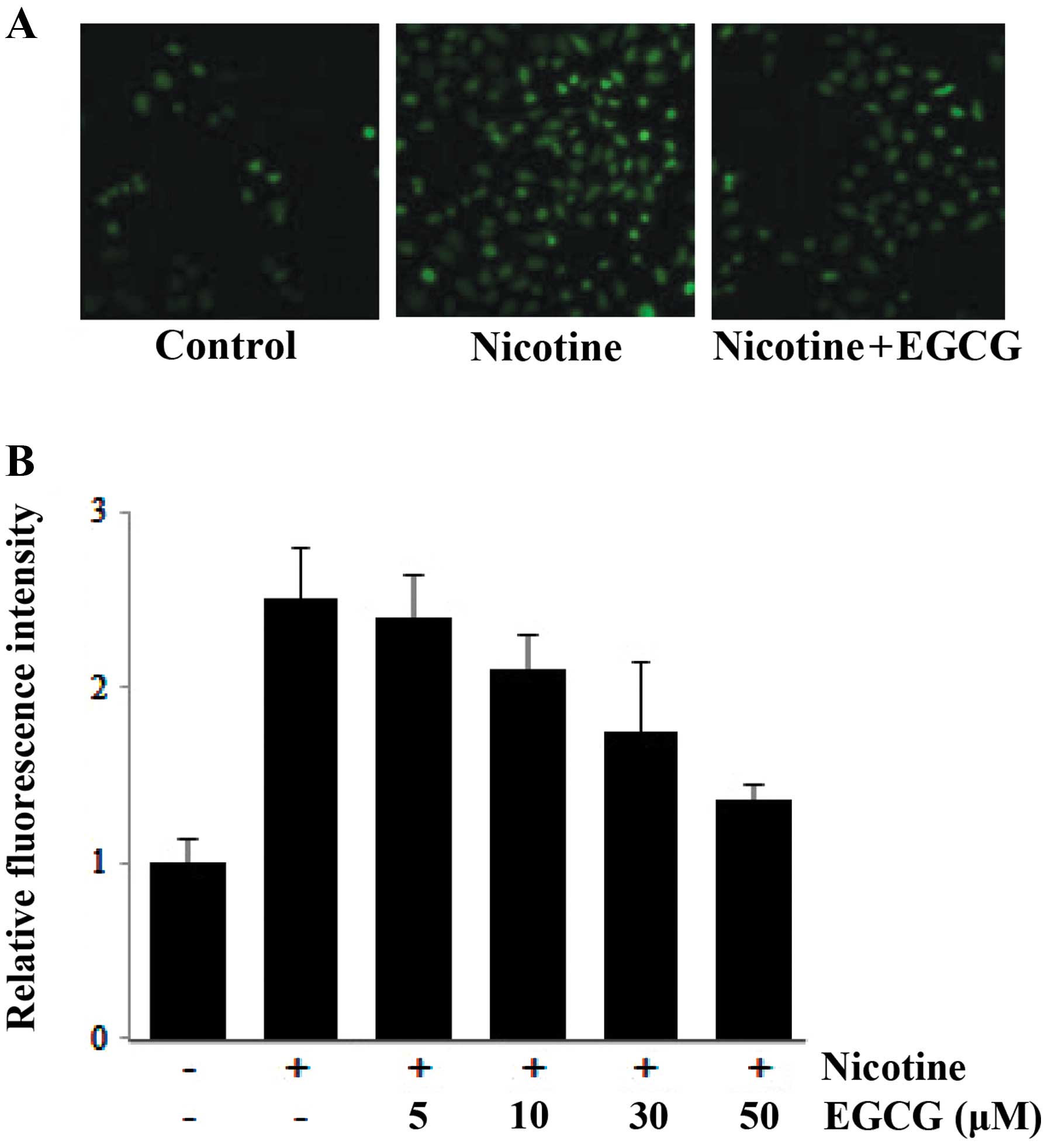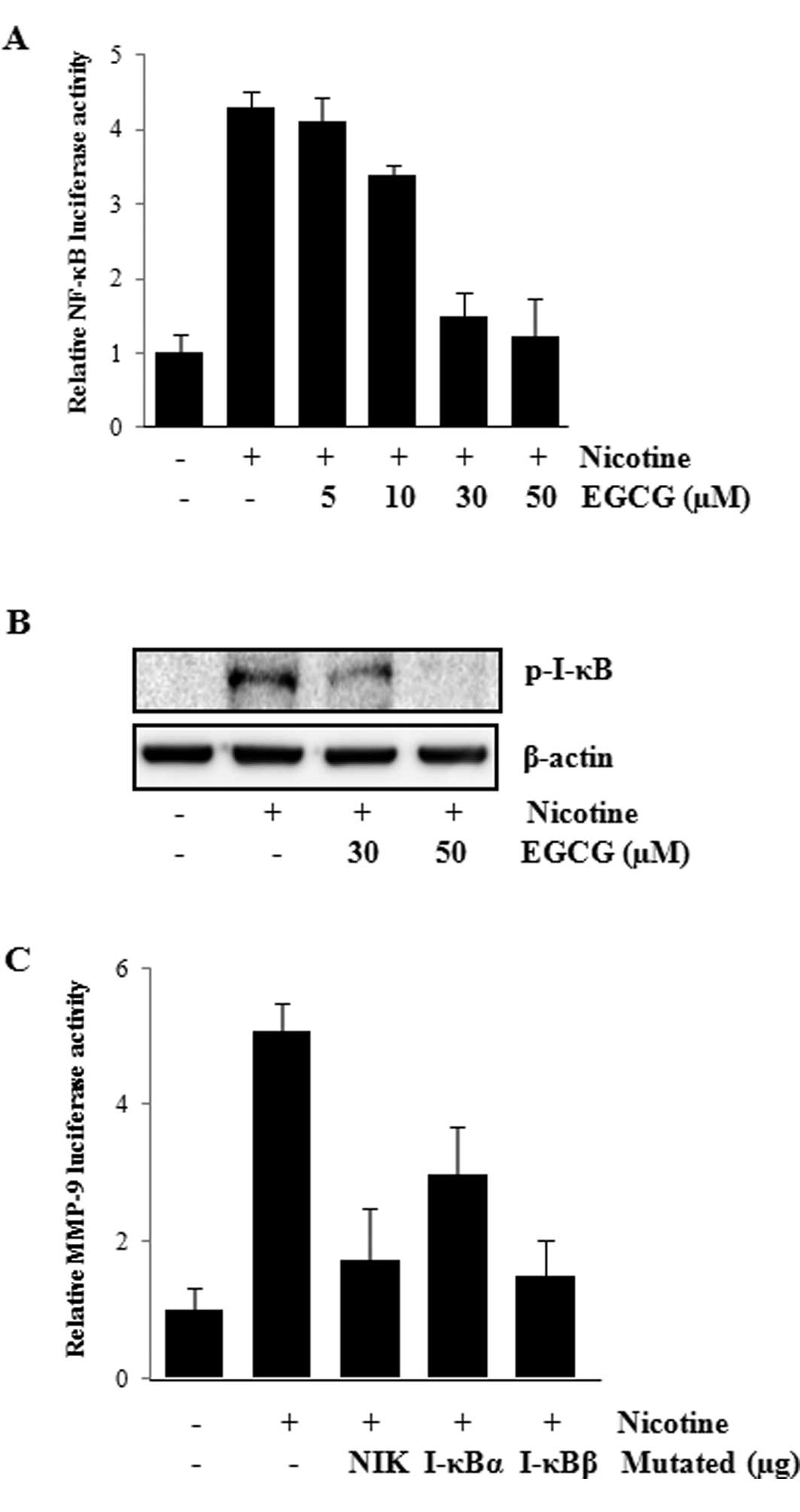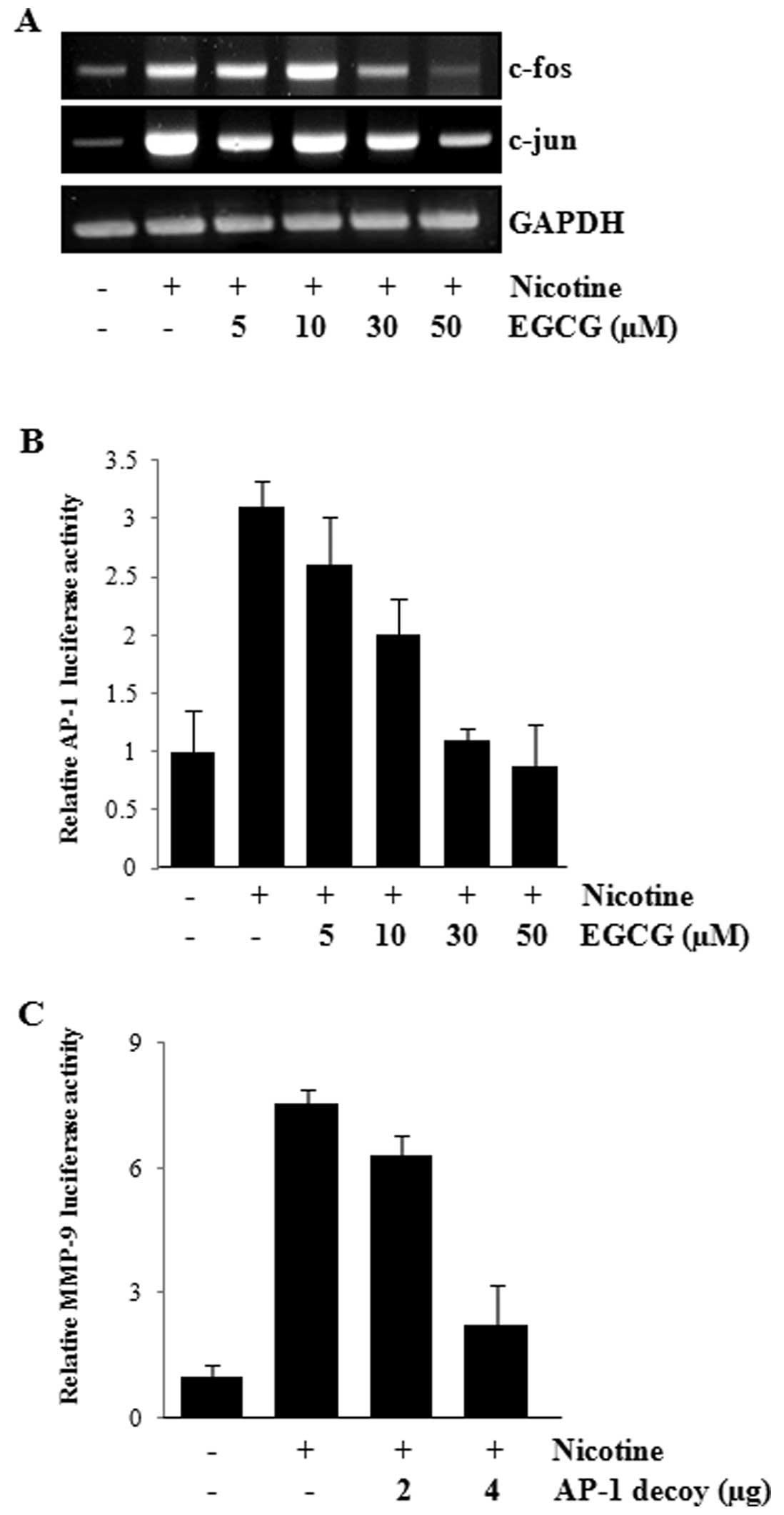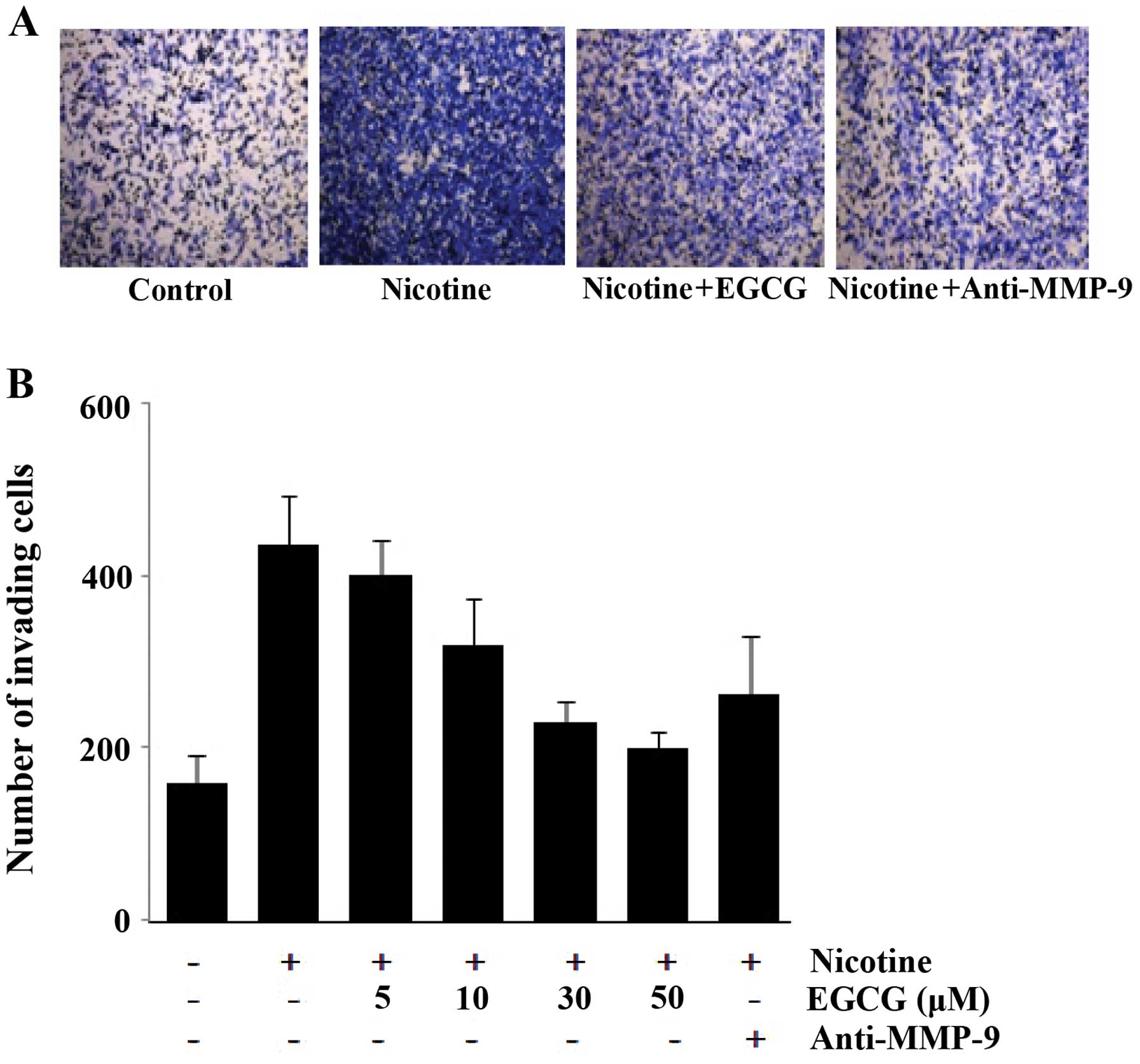(-)-Epigallocatechin-3-gallate blocks nicotine-induced matrix metalloproteinase-9 expression and invasiveness via suppression of NF-κB and AP-1 in endothelial cells
- Authors:
- Published online on: July 5, 2013 https://doi.org/10.3892/ijo.2013.2006
- Pages: 868-876
Abstract
Introduction
Chemical-analytical studies have led to the identification of ~3,000 compounds in tobacco. These include carcinogens in processed tobacco as well as tumor initiators, tumor promoters, cocarcinogens and organ-specific carcinogens in tobacco smoke. Some of these compounds such as 4-(methylnitro samino)-1-(3-pyridyl)-1-butanone and N′-nitrosonornicotine are nicotine derivatives and highly carcinogenic (1). Nicotine is the major addictive component of tobacco smoke. Although nicotine is generally thought to have limited ability to initiate cancer, it can induce cell proliferation and angiogenesis in a variety of systems. A recent finding suggested that nicotine may at least be partially involved in the initiation, promotion and even progression of tumors (2). However, the effect of nicotine on cancer cell invasion is still not clear.
Epidemiological studies have shown that the consumption of green tea decreases the risk of developing human cancers (3). The anti-carcinogenic and anti-proliferative effects of green tea have been attributed to the biological activities of its polyphenol components. Green tea extract contains (−)-epicatechin (EC), (−)-epicatechin gallate (ECG), (−)-epigallocatechin (EGC) and (−)-epigallocatechin-3-gallate (EGCG) (4). EGCG, the most abundant polyphenol in green tea, has been considered to be the major chemopreventive constituent of tea and has been the focus of a great deal of attention. EGCG inhibits proliferation and induces apoptosis of tumor cells (5,6). The exact mechanisms underlying the anticarcinogenic activity of tea are not well defined and warrant further study. In addition to having a cancer chemopreventive activity, polyphenols have been shown to inhibit tumor invasion, which is a crucial step for the metastasis of all solid tumors. It was proposed recently that the anticancer activity of EGCG is associated with the inhibition of invasion by inhibiting the matrix metalloproteinases (MMPs) (7), activity of urokinase (8) and removal of oxygen radicals (9), all of which play key roles in cancer invasion and metastasis. Previously, we reported that mice treated with EGCG resulted in marked inhibition of vascularity and proliferation of human colon cancer xenografts model (10).
Cancer invasion and metastasis are multistep processes and require the coordinated action of cell-secreted proteolytic enzymes and their inhibitors. Matrix metalloproteinases (MMPs) are a family of zinc containing enzymes which are involved in the degradation of different components of the extracellular matrix and there is considerable evidence indicating that individual MMPs have important roles in tumor invasion and spread (11). Of the MMPs, MMP-9 (gelatinase B) cleaves matrix substrates including gelatin and collagen types IV, V and VII (12). In addition, several extracellular stimuli have been reported to regulate the activities of MMPs in various cell types (13,14). In cancer, it has recently been reported that MMP-9 is related to the initial step of cancer cell invasion and that the plasma level of MMP-9 in patients correlates with the tumor metastatic potential. As reported in related studies (15,16), it is clear that MMP-mediated degradation of extracellular matrix is a hallmark in several pathologic conditions such as arthritis, inflammation, cancer, angiogenesis, cardiovascular, pulmonary, ocular, gastrointestinal and oral diseases. Invasion and metastasis, both fundamental properties of malignant cancer cells, are the end result of a complex series of steps involving multiple tumor-host interactions (17,18). As a result, cancer cell migration and invasion of surrounding tissues are mediated in part by MMPs, especially MMP-9 (19,20).
In this study, the inhibitory effects of EGCG and its molecular mechanism on nicotine-induced MMP-9 and cell invasiveness in human ECV304 endothelial cells were examined.
Materials and methods
Cell culture and culture conditions
Human endothelial ECV304 cells obtained from the American Type Culture Collection (Manassas, VA, USA) were cultured in Dulbecco’s modified Eagle’s medium, supplemented with 10% fetal bovine serum (FBS) and 1% penicillin-streptomycin at 37°C in an atmosphere containing 5% CO2. To determine the effects of nicotine on MMP-9 expression, cells treated with nicotine at various concentrations were harvested and the level of MMP-9 messenger RNA (mRNA), protein and promoter activity were determined. The role of EGCG (Sigma-Aldrich, St. Louis, MO, USA) in the nicotine-induced expression of MMP-9 was examined by pretreating the ECV304 cells with EGCG for 1 h before exposure to nicotine.
Reverse transcription-PCR
Total RNA was extracted from the ECV304 cells using TRIzol reagent (Invitrogen, Carlsbad, CA, USA). One microgram of total RNA was used for first-strand complementary DNA synthesis using random primers and the SuperScript reverse transcriptase (Invitrogen). The complementary DNA was subjected to PCR amplification with the primer sets for glyceraldehyde 3-phosphate dehydrogenase (GAPDH), MMP-9, c-fos and c-jun. The specific primer sequences were as follows: GAPDH sense, 5′-TTG TTG CCA TCA ATG ACC CC-3′; GAPDH antisense, 5′-TGA CAA AGT GGT CGT TGA GG-3′ (836 bp); MMP-9 sense, 5′-AAG TGG CAC CAC CAC AAC AT-3′; MMP-9 antisense, 5′-TTT CCC ATC AGC ATT GCC GT-3′ (516 bp); c-fos sense, 5′-AAC CGG AGG AGG GAG CTG ACT GAT-3′; c-fos antisense, 5′-GGG CCT GGA TGA TGC TGG GAA CA-3′ (375 bp); c-jun sense, 5′-ATG GAG TCC CAG GAG CGG ATC AA-3′; and c-jun antisense, 5′-GTT TGC AAC TGC TGC GTT AG-3′ (251 bp). The PCR conditions were as follows: denaturation at 94°C for 30 sec, annealing at 58°C for 30 sec and extension at 72°C for 45 sec. The products were electrophoresed in 1.5% agarose gel containing ethidium bromide.
Western blot analysis
The cells were washed in phosphate-buffered saline (PBS), detached using trypsin-EDTA buffer and stored at −70°C until needed. The protein was extracted with RIPA buffer [1% NP-40, 0.5% sodium deoxycholate, 0.1% sodium dodecyl sulfate (SDS)], protease inhibitors [aprotinin, leupeptin, phenylmethanesulfonylfluoride (PMSF), benzamidine, trypsin inhibitor and sodium orthovanadate]. Fifty micrograms of the protein was then separated by 10% SDS-PAGE and transferred to polyvinylidene fluoride membranes. The membranes were blocked in a PBS solution containing 5% non-fat dry milk, incubated with the primary antibodies in a blocking solution overnight at 4°C and washed three times with TTBS (0.1% Tween-20 in TBS) at 10-min intervals. Horseradish peroxidase-conjugated secondary antibodies (Amersham, Arlington Heights, IL, USA) were used to detect the immunoreactive proteins by chemiluminescence. The following antibodies were used: anti-MMP-9 (R&D Systems, Inc, Minneapolis, MN, USA) and anti-phospho-IκB (Santa Cruz Biotechnology, Santa Cruz, CA, USA). The total protein levels were assayed by washing the blotted membrane with a stripping solution composed of 100 mM 2-mercaptoethanol, 2% SDS and 62.5 mM Tris-HCl (pH 6.7) for 30 min at 50°C and the membrane was then reprobed with anti-β-actin (Sigma-Aldrich) monoclonal antibodies.
Gelatin zymography
The quantity of protein in the conditioned media was determined with a BSA protein assay kit (Pierce, USA). Subsequently, the conditioned media was mixed with an equal volume of 2X sample loading buffer [62.5 mM Tris-HCl (pH 6.8), 25% glycerol, 4% sodium dodecyl sulfate (SDS) and 0.01% bromophenol blue; Bio-Rad, USA] and loaded onto a 7.5% acrylamide:bisacrylamide (29:1; Bio-Rad) gel containing 625 μg/ml gelatin (Sigma). Upon electrophoresis at 100 V for 2 h, the gel was soaked in 1X zymogram renaturation buffer (Bio-Rad) on a rocker for 1.5 h at room temperature to remove residual SDS, rinsed in distilled water, incubated at 37°C for 18 h in 1X zymogram development buffer (Bio-Rad), stained with 0.25% (w/v) coomassie brilliant blue R-250 (Bio-Rad) and then destained in destaining buffer (10% acetic acid and 20% methanol).
Quantitation of MMP-9
The amounts of MMP-9 in conditioned media from ECV304 cells were determined using commercially available enzyme-linked immunosorbent assay (ELISA) kits (R&D Systems) according to the manufacturer’s instructions.
Measurement of MMP-9 promoter activity
The transcriptional regulation of MMP-9 was examined by the transient transfection of an MMP-9 promoter luciferase reporter construct (pGL4-MMP-9). The plasmid pGL4-MMP-9 promoter (21) was kindly provided by Dr Young Han Lee (Konkuk University, Korea). ECV304 cells (5×105) were seeded and grown until they reached 60–70% confluence, then pRL-TK (an internal control plasmid containing the herpes simplex thymidine kinase promoter linked to the constitutively active Renilla luciferase reporter gene) and pGL4-MMP-9 were cotransfected into the cells using FuGene (Boehringer-Mannheim, Mannheim, Germany), according to the manufacturer’s protocol. pRL-TK was transfected as an internal control. Cells were incubated in the transfection medium for 20 h and treated with nicotine for 5 h. The effects of signaling inhibitors on MMP-9 promoter activity were determined by pretreating cells with EGCG for 1 h prior to addition of nicotine. The cotransfection studies were performed in the presence or absence of NF-κB-inducting kinase (NIK), I-κBα or I-κBβ and AP-1 decoy oligodeoxynucleotides (ODNs). The dominant negative mutants of I-κBα, I-κBβ and NIK were kindly provided by Dr D.W. Ballard (22) and Dr W.C. Greene (23), respectively. The phosphorothioate double-stranded ODNs with the sequences against the AP-1 binding site (5′-CAC TCA GAA GTC ACT TC-3′ and 3′-GAA GTG ACT TCT GAG CTG-5′) were prepared (Genotech, St. Louis, MO, USA) and annealed (AP-1 decoy ODNs).
Measurement of intracellular hydrogen peroxide (H2O2)
The level of intracellular H2O2 was measured using 5- and 6-carboxyl-2′, 7′-dichlorodihydrofluorescein diacetate (DCFDA, Molecular Probes, Eugene, OR, USA) according to a previously-described procedure (24). Briefly, the cells were grown in serum-starved DMEM medium supplemented with 0.5% FBS for an additional 2 days. The cells were then stabilized in a serum-free DMEM medium without phenol red for ≥30 min before being exposed to nicotine for 15 min. The effect of EGCG was assessed by pretreating the cells with EGCG for 1 h and incubating them with nicotine sensitive fluorophore DCFDA (5 ng/ml) for 10 min. The cells were observed immediately under a laser-scanning confocal microscope. The DCF fluorescence was excited at 488 nm using an argon laser and the emission evoked was filtered with a 515-nm long pass filter.
Transient transfection of NF-κB and AP-1 reporter
The NF-κB and AP-1 reporter construct was purchased from Clontech (Palo Alto, CA, USA). Once the cells had reached 60–70% confluence, they were washed with Dulbecco’s modified Eagle’s medium and incubated in the medium without serum and antibiotics for 18 h. The cells were then transfected with NF-κB and AP-1 reporter containing the pGL3 vector using Lipofectamine 2000 (Invitrogen). Reporter transfected cells were pretreated with EGCG for 1 h and incubated with 200 μg/ml nicotine for 5 h. The luciferase activity was measured using a luminometer.
Matrigel invasion assay
ECV304 cells (5×104) in 250 μl of complete DMEM were seeded in the upper chamber of a 10-well chemotaxis chamber (Neuro Probe, USA) and serum-free DMEM was placed in the lower chamber. A Matrigel-coated membrane was inserted between the two chambers. Following overnight incubation at 37°C, the media in the upper chamber was replaced with serum-free DMEM and ECV304 cells were preincubated with the indicated concentration of EGCG and anti-MMP-9 antibody for 1 h and added to 200 μg/ml nicotine for 24 h. Upon additional 24 h incubation at 37°C in 5% CO2 air, the membrane was fixed and stained with a Hemacolor rapid staining kit (Merck, Germany) as per the manufacturer’s instructions.
Statistics
Data are shown as the mean ± SD and represent the mean of at least three separate experiments performed in triplicate. Differences between data sets were determined by Student’s t-test. Differences described as significant in the text correspond to P<0.05.
Results
MMP-9 expression induced by nicotine in human ECV304 endothelial cells
To determine the induction of MMP-9 expression by nicotine in human ECV304 endothelial cells, the cells were incubated with nicotine at 0–500 μg/ml. The level of MMP-9 mRNA and protein in the cells were determined by reverse transcription-PCR and western blot analysis, respectively. As shown in Fig. 1A and B, nicotine induced MMP-9 mRNA and protein expression in a dose-dependent manner. Similarly to other members of the metalloproteinase family, MMP-9 is secreted as a pro-enzyme and then activated by proteolytic cleavage extracellularly (25). Since MMP-9 plays a pivotal role in tumor cell invasiveness, we examined the effect of nicotine on MMP-9 enzyme activities. For this goal, we performed gelatin zymography and ELISA with conditioned media harvested from nicotine-treated ECV304 cells. The gelatinolytic activity of MMP-9 was upregulated with increasing concentrations of nicotine (Fig. 1C). The level of MMP-9 was also increased by treating with nicotine determined by ELISA (Fig. 1D). Next, the effect of nicotine on transcriptional regulation of the MMP-9 gene was examined. To this end, ECV304 cells were transiently transfected with the MMP-9 promoter luciferase reporter construct (pGL4-MMP-9) and the MMP-9 promoter activity was determined. The cells treated with nicotine displayed an increase in MMP-9 promoter activity in a dose-dependent manner (Fig. 1E).
Suppressive effect of EGCG on nicotine-induced MMP-9 upregulation in human ECV304 endothelial cells
To examine the inhibitory effect of EGCG against MMP-9 enzymatic activity, ECV304 endothelial cells were subjected to RT-PCR and western blot analysis. In the presence of increased concentrations of EGCG (0, 5, 10, 30 and 50 μM) following nicotine stimulation, MMP-9 expressions were shown to be reduced in a dose-dependent manner (Fig. 2A and B). The inhibitory effects of EGCG on MMP-9 induction could also be confirmed by zymographic analysis and ELSIA assay, respectively (Fig. 2C and D). Next, we investigated whether the EGCG treatment inhibited the MMP-9 transcriptional activity induced by nicotine. As shown in Fig. 2E, cells pretreated with 10–50 μM EGCG lost most of the nicotine-induced MMP-9 transcriptional activity. EGCG at the concentrations used did not affect cell viability (data not shown).
Inhibition of nicotine-induced ROS production by EGCG
Since the ROS was known to be intracellular molecules to regulate various genes (26), we determined the role of ROS in which EGCG suppressed nicotine-induced MMP-9. The changes in the level of ROS were assayed using the H2O2 sensitive fluorophore DCFDA in human ECV304 endothelial cells treated with nicotine. Nicotine induced the production of ROS in the cells and pretreating the cells with 0–50 μM EGCG inhibited the production of ROS in a dose-dependent manner (Fig. 3).
Effect of EGCG on the activation of transcription factor NF-κB during nicotine-induced MMP-9 expression
Considering that nicotine can generate ROS and that NF-κB is a redox sensitive transcription factor (27,28), the roles of NF-κB in the inhibitory effect of EGCG on MMP-9 expression were investigated. NF-κB-dependent transcription study showed that EGCG inhibited nicotine activated NF-κB in a dose-dependent manner (Fig. 4A). To gain further insight into the mechanism of EGCG-mediated downregulation of NF-κB, the effects of EGCG on the I-κB phosphorylation were examined. Activation of NF-κB is usually associated with the induction of I-κB phosphorylation, which is followed by its degradation by proteasome, NF-κB nuclear translocation and subsequent activation of target gene expression. The change in the amount of I-κB phosphorylation in ECV304 cells was determined by western blotting using an antibody to I-κB phosphorylation. As shown in Fig. 4B, EGCG inhibited the nicotine-induced phosphorylation of I-κB. The involvement of NF-κB in the induction of MMP-9 by nicotine was confirmed by cotransfecting ECV304 cells with the MMP-9 promoter reporter and the dominant negative mutant forms of NF-κB-related molecules. As shown in Fig. 4C, the expression of dominant negative mutant forms of NIK, I-κBα, or I-κBβ resulted in a decrease of the nicotine-induced MMP-9 promoter activity. These data indicated that NF-κB may be a crucial molecule in the inhibitory effect of EGCG on MMP-9 expression induced by nicotine.
Role of AP-1 in EGCG-mediated MMP-9 regulation
The above results indicated that EGCG could inhibit the nicotine induced MMP-9 expression at the transcriptional level. Several tentative transcription factors, including NF-κB and AP-1, have been suggested to control the MMP-9 expression (29). AP-1, which consists of subunits c-fos and c-jun, is the downstream transcriptional target of Erk1/2 and JNK (30,31). To determine if EGCG regulates c-fos and c-jun activation induced by nicotine, the expression of c-fos and c-jun were determined by RT-PCR. As shown in Fig. 5A, EGCG inhibited the nicotine-induced c-fos and c-jun expression in a dose-dependent manner. Furthermore, EGCG treatment caused a decrease in the AP-1-dependent transcriptional activity, as revealed by the transient transfection study using pAP-1-luciferase reporter construct (Fig. 5B). To confirm that AP-1 plays an important role in the MMP-9 expression in endothelial cells, the cells were transiently transfected with AP-1 decoy oligonucleotides and change in the MMP-9 promoter activity was examined. As shown in Fig. 5C, the MMP-9 activity was significantly decreased by AP-1 decoy transfection. The above results suggest that the transcription factor AP-1 is also involved in nicotine-induced MMP-9 expression and be a molecular target in EGCG-mediated MMP-9 regulation.
Effect of EGCG and anti-MMP-9 antibody on nicotine-induced cell invasion
To examine if EGCG and anti-MMP-9 antibody inhibit nicotine-induced cell invasion, modified Boyden chamber systems were employed. As shown in Fig. 6, EGCG and anti-MMP-9 antibody inhibited the invasiveness of ECV304 cells stimulated by nicotine. These results show that EGCG was able to suppress cell invasion via blocking MMP-9 expression.
Discussion
In endothelial cells, a potential role of the tea polyphenol (−)-epigallocatechin-3-gallate (EGCG), a major component of green tea, on nicotine-induced MMP-9 and cell invasion were investigated. To achieve our goal, we employed human ECV304 endothelial cells that had undergone spontaneous immortalization from human umbilical vein endothelial cell (HUVEC). HUVEC has been used for many studies of endothelial cell function. However, as primary isolates, these cells exhibit a limited life span in culture and do not survive in serum-deprivation conditions used in our systems. ECV304 cells have been shown to respond to extracellular growth factors, are contact inhibited and differentiate when grown on extracellular matrix (32).
The present study suggests that EGCG inhibited nicotine-induced MMP-9 and cell invasion in ECV304 endothelial cells. Interest in green tea as a cancer chemopreventive agent in humans has intensified for several reasons (33). First, epidemiological evidence suggests that people who consume a large amount of green tea have a lower risk of various cancers. Second, green tea has been shown in animal models to protect against the development and progression of skin, lung, mammary gland and gastrointestinal tract tumors. Third, green tea extracts have been shown in vitro to stimulate apoptosis of various cancer cell lines, including prostate, lymphoma, colon and lung. Finally, green tea consumption is associated with few adverse events and it is readily available at low cost.
Nicotine alone or in combination with other substances present in the cigarette smoking is recognized as an agent for the modulation of key cellular processes involved in the pathobiological effects of tobacco (34). Nicotine has been shown to enhance cell migration, invasion and subsequent metastasis in many cancer cells (35). In addition, Jacob-Ferreira et al(36) has suggested that nicotine produces cardiovascular effects involving MMP-9. MMP-9 plays a key role in the degradation of the extracellular matrix, which is required for various pathophysiologic responses (37). Several studies have reported convincing evidence that suppression of MMPs by different inhibitors markedly reduced tumor cell invasiveness and metastasis (38,39). Elevated levels and activities of MMP-9 are found in cancer tissues and tumor cells. Due to the significant role that MMPs play in cancer as well as additional human pathologies, considerable interest has focused on investigating of plant-derived compounds that can inhibit MMP activities.
Reactive oxygen species (ROS) are important messenger molecules in downstream signaling pathways and can ultimately lead to the induction of invasion-related genes including those for the MMPs (40). Our results show that nicotine stimulates the intracellular ROS production and EGCG suppress the ROS production, as determined with H2O2-sensitive fluorophore DCFDA. The molecular mechanism for the ROS production by nicotine remains to be elucidated. Asano et al(41) reported that nicotine activates PKC, which stimulates NADPH oxidase to generate ROS in C6 glioma cells. However, non-NADPH oxidase-dependent sources, including mitochondrial electron transport, may also be importantly involved in the nicotine-induced ROS generation. EGCG has strong antioxidative capacity, high affinity for the lipid bilayers of the cell membrane and can easily enter the nuclei of cancer cells (42). EGCG is water soluble and readily oxidizable (43). Its catechol structure also makes EGCG a strong chelator of metal ions. EGCG can bind the transition metal ions, prevent formation of hydroxyl radicals and thus inhibit exogenous ROS-potentiated tumor invasion (44). Therefore, EGCG could inhibit tumor cell invasion by scavenging oxygen radicals.
This study demonstrated that the suppression of nicotine-induced MMP-9 expression by EGCG occurred at the transcriptional level as revealed by a transient transfection study using the MMP-9 promoter luciferase reporter construct. A portion of the 5′-flanking region of the MMP-9 gene has been cloned. The promoter of the MMP-9 gene contains AP-1 (−533, −79), NF-κB (−600), PEA3 (−540) and Sp1 (−558) sites for stimuli that can induce MMP-9 expression (45). EGCG inhibited the level of active NF-κB and AP-1 induced by nicotine, indicating that NF-κB and AP-1 inhibition is crucial in the suppression of MMP-9 expression by EGCG in human ECV304 endothelial cells.
The following observations suggest that the inhibition of NF-κB by EGCG is involved in MMP-9 gene regulation in ECV304 cells: i) the nicotine treatment increased I-κB phosphorylation and NF-κB-dependent transcriptional activity; ii) EGCG inhibits nicotine-induced I-κB phosphorylation and NF-κB-dependent transcriptional activity; and iii) MMP-9 transcriptional activity was inhibited by transfection with mutated NIK, I-κBα or I-κBβ. The potent antioxidative capacity of EGCG may contribute to the prevention of NF-κB activation. Since the ROS was known to activate NF-κB through the phosphorylation of I-κB, EGCG may prevent the ROS induction of NF-κB activation in MMP-9 gene expression. The results that ROS production was increased within 15 min after exposing the cells to nicotine and the level of ROS were attenuated by EGCG supported the above assumption.
In the subsequent experiments, the role of AP-1 in the inhibitory effects of EGCG on nicotine-induced MMP-9 expression was also investigated. The active AP-1 complex may comprise a homodimer of c-jun or heterodimers between c-fos, c-jun and ATF2 (46). The c-jun is activated by N-terminal phosphorylation of specific serine residues (ser63/73) and it appears to be exclusively activated by JNK. The c-fos activation can be regulated by JNK and Erk signal pathways (47). Gum et al(48) suggested that regulation of MMP-9 expression in UMSCC-1 cells was regulated by JNK- and Erk-dependent signaling pathways. Simon et al(49) demonstrated that phorbol ester-enhanced MMP-9 secretion and in vitro cell invasiveness were associated with activation of p38 MAPK. In this study, EGCG suppressed nicotine-induced c-fos and c-jun expression and AP-1 activity. Since EGCG inhibited phosphorylation of receptor tyrosine kinase, it would be logical to assume that the reduction in activity of mitogen-activated protein kinase (MAPK) and AP-1 were due to the reduction in receptor activities. Previously, we showed that EGCG could directly inhibit MAPK activities in a cell-free system, although the mechanism by which EGCG inhibited the MAPK activities in the cell-free system remained to be clarified. Thus, the nicotine-induced AP-1 might be inhibited by dual effects of EGCG in the cells: the suppression of receptor phosphorylation and direct inhibition of MAPK activities.
Our results suggest new insight into how EGCG may be involved in nicotine-induced MMP-9 expression and cell invasion in endothelial cells. Further studies are needed to elucidate the detailed mechanisms by which EGCG inhibits the MMP-9 expression and to examine whether EGCG, in fact, exerts the same effects in vivo.
Acknowledgements
This study was supported by a research grant (0720570) from the National Cancer Center, by the National Research Foundation of Korea (NRF) grant (Basic Research Program, 2010-0009910 and MRC for Gene Regulation, 2011-0030132) funded by the Korea government (MSIP).
References
|
Brunnemann KD and Hoffmann D: Analytical studies on tobacco-specific N-nitrosamines in tobacco and tobacco smoke. Crit Rev Toxicol. 21:235–240. 1991. View Article : Google Scholar : PubMed/NCBI | |
|
Davis R, Rizwani W, Banerjee S, Kovacs M, Haura E, Coppola D and Chellappan S: Nicotine promotes tumor growth and metastasis in mouse models of lung cancer. PLoS One. 4:e75242009. View Article : Google Scholar : PubMed/NCBI | |
|
Ji BT, Chow WH, Hsing AW, McLaughlin JK, Dai Q, Gao YT, Blot WJ and Fraumeni JF Jr: Green tea consumption and the risk of pancreatic and colorectal cancers. Int J Cancer. 70:255–258. 1997. View Article : Google Scholar : PubMed/NCBI | |
|
Stoner GD and Mukhtar H: Polyphenols as cancer chemopreventive agents. J Cell Biochem (Suppl). 22:169–180. 1995. View Article : Google Scholar : PubMed/NCBI | |
|
Paschka AG, Butler R and Young CY: Induction of apoptosis in prostate cancer cell lines by the green tea component, (−)-epigallocatechin-3-gallate. Cancer Lett. 130:1–7. 1998. | |
|
Jung YD, Kim MS, Shin BA, Chay KO, Ahn BW, Liu W, Bucana CD, Gallick GE and Ellis LM: EGCG, a major component of green tea, inhibits tumour growth by inhibiting VEGF induction in human colon carcinoma cells. Br J Cancer. 84:844–850. 2001. View Article : Google Scholar : PubMed/NCBI | |
|
Sen T, Dutta A and Chatterjee A: Epigallocatechin-3-gallate (EGCG) downregulates gelatinase-B (MMP-9) by involvement of FAK/ERK/NFkappaB and AP-1 in the human breast cancer cell line MDA-MB-231. Anticancer Drugs. 21:632–644. 2010. View Article : Google Scholar : PubMed/NCBI | |
|
Kim MH, Jung MA, Hwang YS, Jeong M, Kim SM, Ahn SJ, Shin BA, Ahn BW and Jung YD: Regulation of urokinase plasminogen activator by epigallocatechin-3-gallate in human fibrosarcoma cells. Eur J Pharmacol. 487:1–6. 2004. View Article : Google Scholar : PubMed/NCBI | |
|
Shen JZ, Zheng XF, Wei EQ and Kwan CY: Green tea catechins evoke a phasic contraction in rat aorta via H2O2-mediated multiple-signalling pathways. Clin Exp Pharmacol Physiol. 30:88–95. 2003. View Article : Google Scholar : PubMed/NCBI | |
|
Jung YD and Ellis LM: Inhibition of tumour invasion and angiogenesis by epigallocatechin gallate (EGCG), a major component of green tea. Int J Exp Pathol. 82:309–316. 2001. View Article : Google Scholar : PubMed/NCBI | |
|
Parsons SL, Watson SA, Brown PD, Collins HM and Steele RJ: Matrix metalloproteinases. Br J Surg. 84:160–166. 1997. View Article : Google Scholar | |
|
Chandler S, Miller KM, Clements JM, Lury J, Corkill D, Anthony DC, Adams SE and Gearing AJ: Matrix metalloproteinases, tumor necrosis factor and multiple sclerosis: an overview. J Neuroimmunol. 72:155–161. 1997. View Article : Google Scholar : PubMed/NCBI | |
|
Ogata Y, Pratta MA, Nagase H and Arner EC: Matrix metalloproteinase 9 (92-kDa gelatinase/type IV collagenase) is induced in rabbit articular chondrocytes by cotreatment with interleukin 1 beta and a protein kinase C activator. Exp Cell Res. 201:245–249. 1992. View Article : Google Scholar | |
|
Ma Z, Qin H and Benveniste EN: Transcriptional suppression of matrix metalloproteinase-9 gene expression by IFN-gamma and IFN-beta: critical role of STAT-1alpha. J Immunol. 167:5150–5159. 2001. View Article : Google Scholar : PubMed/NCBI | |
|
Vartak DG and Gemeinhart RA: Matrix metalloproteases: underutilized targets for drug delivery. J Drug Target. 15:1–20. 2007. View Article : Google Scholar : PubMed/NCBI | |
|
Konstantinopoulos PA, Karamouzis MV, Papatsoris AG and Papavassiliou AG: Matrix metalloproteinase inhibitors as anticancer agents. Int J Biochem Cell Biol. 40:1156–1168. 2008. View Article : Google Scholar : PubMed/NCBI | |
|
Woodhouse EC, Chuaqui RF and Liotta LA: General mechanisms of metastasis. Cancer. 80:1529–1537. 1997. View Article : Google Scholar : PubMed/NCBI | |
|
Mehlen P and Puisieux A: Metastasis: a question of life or death. Nat Rev Cancer. 6:449–458. 2006. View Article : Google Scholar : PubMed/NCBI | |
|
Arii S, Mise M, Harada T, Furutani M, Ishigami S, Niwano M, Mizumoto M, Fukumoto M and Imamura M: Overexpression of matrix metalloproteinase 9 gene in hepatocellular carcinoma with invasive potential. Hepatology. 24:316–322. 1996. View Article : Google Scholar : PubMed/NCBI | |
|
Klein G, Vellenga E, Fraaije MW, Kamps WA and de Bont ES: The possible role of matrix metalloproteinase (MMP)-2 and MMP-9 in cancer, e.g acute leukemia. Crit Rev Oncol Hematol. 50:87–100. 2004. View Article : Google Scholar : PubMed/NCBI | |
|
Shin SY, Kim JH, Baker A, Lim Y and Lee YH: Transcription factor Egr-1 is essential for maximal matrix metalloproteinase-9 transcription by tumor necrosis factor alpha. Mol Cancer Res. 8:507–519. 2010. View Article : Google Scholar : PubMed/NCBI | |
|
McKinsey TA, Brockman JA, Scherer DC, Al-Murrani SW, Green PL and Ballard DW: Inactivation of IkappaBbeta by the tax protein of human T-cell leukemia virus type 1: a potential mechanism for constitutive induction of NF-kappaB. Mol Cell Biol. 16:2083–2090. 1996.PubMed/NCBI | |
|
Geleziunas R, Ferrell S, Lin X, Mu Y, Cunningham ET Jr, Grant M, Connelly MA, Hambor JE, Marcu KB and Greene WC: Human T-cell leukemia virus type 1 Tax induction of NF-kappaB involves activation of the IkappaB kinase alpha (IKKalpha) and IKKbeta cellular kinases. Mol Cell Biol. 18:5157–5165. 1998.PubMed/NCBI | |
|
Hwang YS, Jeong M, Park JS, Kim MH, Lee DB, Shin BA, Mukaida N, Ellis LM, Kim HR, Ahn BW and Jung YD: Interleukin-1beta stimulates IL-8 expression through MAP kinase and ROS signaling in human gastric carcinoma cells. Oncogene. 23:6603–6611. 2004. View Article : Google Scholar : PubMed/NCBI | |
|
Mizuma M, Katayose Y, Yamamoto K, Shiraso S, Sasaki T, Yabuuchi S, Oda A, Masuda K, Rikiyama T, Onogawa T, Ohtsuka H, Motoi F, Egawa S and Unno M: Up-regulated p27Kip1 reduces matrix metalloproteinase-9 and inhibits invasion of human breast cancer cells. Anticancer Res. 28:2669–2677. 2008. | |
|
Poulsen HE, Jensen BR, Weimann A, Jensen SA, Sørensen M and Loft S: Antioxidants, DNA damage and gene expression. Free Radic Res. 33:33–39. 2000. | |
|
Park MJ, Lee JY, Kwak HJ, Park CM, Lee HC, Woo SH, Jin HO, Han CJ, An S, Lee SH, Chung HY, Park IC, Hong SI and Rhee CH: Arsenic trioxide (As2O3) inhibits invasion of HT1080 human fibrosarcoma cells: role of nuclear factor-kappaB and reactive oxygen species. J Cell Bochem. 95:955–969. 2005.PubMed/NCBI | |
|
Tobar N, Villar V and Santibanez JF: ROS-NFkappaB mediates TGF-beta1-induced expression of urokinase-type plasminogen activator, matrix metalloproteinase-9 and cell invasion. Mol Cell Biochem. 340:195–202. 2010. View Article : Google Scholar : PubMed/NCBI | |
|
Kim HS, Kim MH, Jeong M, Hwang YS, Lim SH, Shin BA, Ahn BW and Jung YD: EGCG blocks tumor promoter-induced MMP-9 expression via suppression of MAPK and AP-1 activation in human gastric AGS cells. Anticancer Res. 24:747–753. 2004.PubMed/NCBI | |
|
Hipskind RA and Bilbe G: MAP kinase signaling cascades and gene expression in osteoblasts. Front Biosci. 3:804–816. 1998.PubMed/NCBI | |
|
Guedea AL, Schrick C, Guzman YF, Leaderbrand K, Jovasevic V, Corcoran KA, Tronson NC and Radulovic J: ERK-associated changes of AP-1 proteins during fear extinction. Mol Cell Neurosci. 47:137–144. 2011. View Article : Google Scholar : PubMed/NCBI | |
|
Iwasaka C, Tanaka K, Abe M and Sato Y: Ets-1 regulates angiogenesis by inducing the expression of urokinase-type plasminogen activator and matrix metalloproteinase-1 and the migration of vascular endothelial cells. J Cell Physiol. 169:522–531. 1996. View Article : Google Scholar : PubMed/NCBI | |
|
Hong MH, Kim MH, Chang HJ, Kim NH, Shin BA, Ahn BW and Jung YD: (−)-Epigallocatechin-3-gallate inhibits monocyte chemotactic protein-1 expression in endothelial cells via blocking NF-kappaB signaling. Life Sci. 80:1957–1965. 2007. | |
|
Wittel UA, Momi N, Seifert G, Wiech T, Hopt UT and Batra SK: The pathobiological impact of cigarette smoke on pancreatic cancer development (Review). Int J Oncol. 41:5–14. 2012.PubMed/NCBI | |
|
Chen RJ, Chang LW, Lin P and Wang YJ: Epigenetic effects and molecular mechanisms of tumorigenesis induced by cigarette smoke: an overview. J Oncol. 2011:6549312011.PubMed/NCBI | |
|
Jacob-Ferreira AL, Palei AC, Cau SB, Moreno H Jr, Martinez ML, Izidoro-Toledo TC, Gerlach RF and Tanus-Santos JE: Evidence for the involvement of matrix metalloproteinases in the cardiovascular effects produced by nicotine. Eur J Pharmacol. 627:216–222. 2010. View Article : Google Scholar : PubMed/NCBI | |
|
Gialeli C, Theocharis AD and Karamanos NK: Roles of matrix metalloproteinases in cancer progression and their pharmacological targeting. FEBS J. 278:16–27. 2011. View Article : Google Scholar : PubMed/NCBI | |
|
Noda M, Oh J, Takahashi R, Kondo S, Kitayama H and Takahashi C: RECK: a novel suppressor of malignancy linking oncogenic signaling to extracellular matrix remodeling. Cancer Metastasis Rev. 22:167–175. 2003. View Article : Google Scholar : PubMed/NCBI | |
|
Lee HY, Park KS, Kim MK, Lee T, Ryu SH, Woo KJ, Kwon TK and Bae YS: A small compound that inhibits tumor necrosis factor-alpha-induced matrix metalloproteinase-9 upregulation. Biochem Biophys Res Commun. 336:716–722. 2005. View Article : Google Scholar : PubMed/NCBI | |
|
Brenneisen P, Briviba K, Wlaschek M, Wenk J and Scharffetter-Kochanek K: Hydrogen peroxide (H2O2) increases the steady-state mRNA levels of collagenase/MMP-1 in human dermal fibroblasts. Free Radic Biol Med. 22:515–524. 1997. | |
|
Asano H, Horinouchi T, Mai Y, Sawada O, Fujii S, Nishiya T, Minami M, Katayama T, Iwanaga T, Terada K and Miwa S: Nicotine- and tar-free cigarette smoke induces cell damage through reactive oxygen species newly generated by PKC-dependent activation of NADPH oxidase. J Pharmacol Sci. 118:275–287. 2012. View Article : Google Scholar : PubMed/NCBI | |
|
Okabe S, Suganuma M, Hayashi M, Sueoka E, Komori A and Fujiki H: Mechanisms of growth inhibition of human lung cancer cell line, PC-9, by tea polyphenols. Jpn J Cancer Res. 88:639–643. 1997. View Article : Google Scholar : PubMed/NCBI | |
|
Graham HN: Green tea composition, consumption and polyphenol chemistry. Prev Med. 21:334–350. 1992. View Article : Google Scholar : PubMed/NCBI | |
|
Zhang G, Miura Y and Yagasaki K: Suppression of adhesion and invasion of hepatoma cells in culture by tea compounds through antioxidative activity. Cancer Lett. 159:169–173. 2000. View Article : Google Scholar : PubMed/NCBI | |
|
Sato H and Seiki M: Regulatory mechanism of 92 kDa type IV collagenase gene expression which is associated with invasiveness of tumor cells. Oncogene. 8:395–405. 1993.PubMed/NCBI | |
|
van Dam H and Castellazzi M: Distinct roles of Jun: Fos and Jun: ATF dimers in oncogenesis. Oncogene. 20:2453–2464. 2001.PubMed/NCBI | |
|
Besirli CG, Wagner EF and Johnson EM Jr: The limited role of NH2-terminal c-Jun phosphorylation in neuronal apoptosis: identification of the nuclear pore complex as a potential target of the JNK pathway. J Cell Biol. 170:401–411. 2005.PubMed/NCBI | |
|
Gum R, Wang H, Lengyel E, Juarez J and Boyd D: Regulation of 92 kDa type IV collagenase expression by the jun aminoterminal kinase- and the extracellular signal-regulated kinase-dependent signaling cascades. Oncogene. 14:1481–1493. 1997. View Article : Google Scholar : PubMed/NCBI | |
|
Simon C, Simon M, Vucelic G, Hicks MJ, Plinkert PK, Koitschev A and Zenner HP: The p38 SAPK pathway regulates the expression of the MMP-9 collagenase via AP-1-dependent promoter activation. Exp Cell Res. 271:344–355. 2001. View Article : Google Scholar : PubMed/NCBI |



